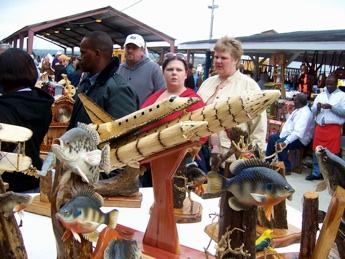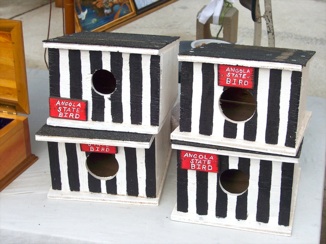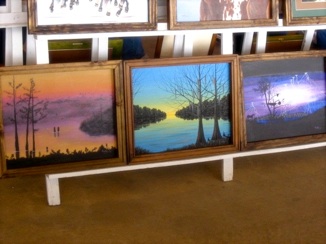11:30 a.m.
At the crafts fair negativity toward the prison system does not sell, but satire does. A popular hobbycraft at the event is the “Angola State Bird Birdhouse”—a small rectangular box painted with black and white stripes and fitted with a bird perch. The men selling these items make them because they are both popular, providing guaranteed income, and easy to construct in the prison’s wood shop (xxvii). The event is relatively absent of art that is critical of the reality of prison life. Many of the men use humor and curiosity as a tool to diffuse any anxiety that tourists might have about approaching them and their work. While the financial benefits of the event are significant, the social capital associated with human interaction is a valuable commodity.
The tactic of engaging potential customers through curiosity was most evident in the work of Kenwood who deals in matchstick art—a classic type of “prison art.” When I met Kenwood he was displaying a replica of the Challenger Space Shuttle built from 10,120 burned matchsticks. The item has a $500.00 price tag and although there are few “buyers” around his table, he is surrounded by spectators. Standing at the corner of the folding table that holds five other original designs, Kenwood tells me “I’d be very happy to sell this piece,” with a big grin on his face—I realize that he misunderstands my status as a graduate student for that of a professor. “It would look great in an office” Kenwood is still grinning, “I’m a poor graduate student” I quickly respond; we both laugh. Kenwood quickly follows by telling me that he enjoys “meeting the people … and getting a chance to talk to people from the free world.” He knows that his artwork will always draw a big crowd; his is some of the most intricate work I have seen at the event. Kenwood adds that he has a collector in Houston, Texas who purchases his work and also helps him sell his inventory after the crafts fair season ends. In a letter he asks me to send him any pictures that I have of his art; he wants to give them to his collector for her website (xxviii). I send Kenwood all the images I have, including the picture I made of the Challenge Space Shuttle on October 22, 2006.
A year later I see Kenwood again. At Angola, one can count on consistency. Kenwood is standing at the same station, in the same location as the year before. His table is steps away from the entrance to the main hobbycraft area; Kenwood and his crafts get a lot of attention. This year Kenwood is displaying his latest creation, a Green Giant Helicopter. I walk over to his table and without a greeting, I lead with: “that’s quite an accomplishment, Kenwood,” he smiles suggesting that he remembers my face, responding with “11,756 matchsticks.” We exchange greetings and a handshake and then begin talking about the items on his table. “I sold the Challenger at the October 28, 2006 rodeo,” he says. “I missed it by a week, I wish I was there,” I tell him. “You’ll be interested in this,” he replies. The guy had me write ‘Angola 2006’ on the bottom; remember how I told you everyone wants something from Angola?” A year earlier, as well as in our written correspondences, Kenwood and I discussed the tourist’s desire for an “authentic experience” and how the “reality” of their visit is represented through a piece of prison art. Jim, another “trustee” at Angola, and I had a very similar conversation. Jim also told me a story about the tourist’s desire to authenticate their experience. Standing among rows of oil paintings, Jim’s preferred craft, I ask him how he decides what to paint. As I look at the rows of swamp and hunting scenes, I get the sense that Jim is playing to a traditional southern audience. I ask Jim about “prison imagery”--artwork reflecting the experience of being incarcerated--and he offers a story about a piece that he painted a few years ago: Listen.
Kenwood and Jim’s experiences demonstrate the tourist’s desire to authenticate the experience of visiting Angola; an experience that is unusual, but not one that is packaged to be taken beyond the gates of the prison. The performance at Angola, as is the case with all embodied (repertoire) performances, is ephemeral and survives only in the memory of the tourist. Solely relying on the memory of an experience is antithetical to the contemporary model of tourism where the expectation is that objects will outlive memories. Because tourists are not permitted to make photographs or capture moving images of the experience, the objects purchased and the memory of the event are the only souvenirs possible. Material objects, as Benjamin observes, become the representation of history. Borrowing from Marcel Proust, Benjamin writes, “the past is somewhere beyond the reach of the intellect, and unmistakably present in some material object” (xxix). The absence of photograph, which is most often cited as the process that makes the greatest contribution to the decline of the “aura”—the unique quality of an original artistic piece, serves to invest the hobbycrafts the men sell with a greater level of value and authenticity. The success of the crafts fair is predicated upon the “inmate-artists” ability to capitalize on the tourist’s desire to memorialize their experience through the purchase of a commodity item.




